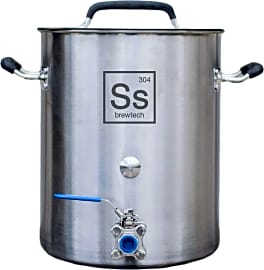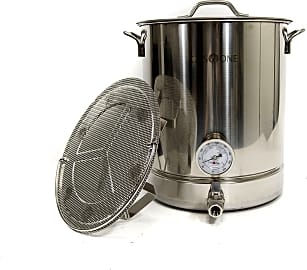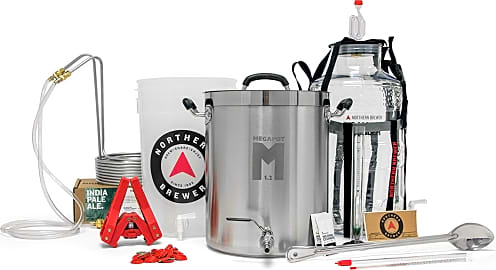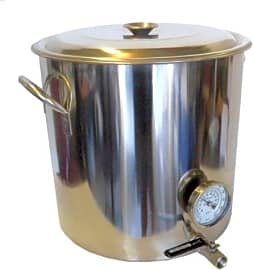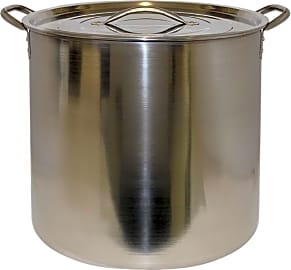The 10 Best Brewing Kettles

This wiki has been updated 34 times since it was first published in October of 2016. If you're old enough to drink it, making your own beer can be an extremely rewarding hobby, not to mention a cost-effective way to stay stocked up on beverages. Whether you’re an extract or all-grain brewer, you’ll need a sturdy kettle for boiling wort. They come in a variety of sizes and designs, some of which include built-in thermometers as well as ball valves for easy drainage. When users buy our independently chosen editorial choices, we may earn commissions to help fund the Wiki.
Editor's Notes
July 08, 2020:
Whether you’re an extract or an all-grain brewer, you’ll need a sturdy kettle for boiling your wort. Our list features smaller models like the Strange Brew Polar Ware which can be used on a kitchen stovetop, as well as much larger models that come in handy when you make large batches that can be doled out to friends in growlers. One such example is the large 16-gallon Bayou Classic 800-416, which can help you to prepare large batches at a time. In today’s update we added in the Northern Brewer Megapot. Unlike some others, this one comes equipped with both a ball valve and a thermometer, so you won’t need to purchase those as separate accessories. It’s also sold as the plain kettle as well as with only the valve. This popular, well-made choice is available in five sizes between eight and 30 gallons, so you’re sure to find the right one for your needs. You can purchase it with confidence, thanks to a money-back satisfaction guarantee. If you’re looking for a full-blown set to get you started with home brewing, the same manufacturer offers an attractive one. The Northern Brewer Set comes with a five-gallon pot as well as a fermenter and a bucket with a spigot, as well as bottling components, cleaning supplies, and a 21-inch stirring spoon. It also comes with the ingredients and a recipe to follow for your choice of beverages called Caribou Slobber and Fresh Squished.
The list wouldn’t be complete without a convenient electric model that doesn’t require a cooktop, so we added in the Brewer’s Edge Mash and Boil, which comes with a generous five-foot power cord and plugs into a standard wall outlet. It’s good for both mashing and boiling, thanks to its precise thermostat and internal sparging basket. For a highly affordable choice that’s basically a stock pot that’s also good for cooking soups, stews, and sauces, look to the Strange Brew Polar Ware. It’s got a five-gallon capacity and a smooth, shiny appearance with a corresponding flat lid. For a selection that’s compatible with induction cooktops, check out the Ss Brewtech BrewMaster. It’s thoughtfully designed with a top lid that can be hung from either side handle, which eliminates the hassle of trying to figure out where to put the lid when you remove it.
No matter which model you choose to go with, practice safe brewing by using potholders when lifting these kettles by their hot handles, and use extreme care when transferring them from a burner or pouring steaming liquid out of them. If you’re brewing in your garage using propane, be sure to keep the area well ventilated to prevent carbon monoxide poisoning.
Special Honors
Stout Brew Kettle This sleek and stylish kettle features heat shields that protect it from harm by helping to prevent scorched elements. It’s made of stainless steel with a mirror-polished finish, and is a breeze to lean. It boasts a large 190-gallon capacity and sports welded-on legs, a sloped bottom, a steam vent, and a bottom trub outlet. conical-fermenter.com
Brewing Through The Ages
They continue to market light beers to this day, although IPAs and stouts are still appreciated by a smaller percentage of alcohol enthusiasts across the United States.
When it came to boozy beverages, the Sumerians had their priorities straight. Historians are fairly certain humans were knocking back barley-based concoctions well before 3400 B.C.E, but the earliest hard evidence comes from around then in the form of residue-covered vessels, age-old receipts, and even an ode to the goddess of beer, Ninkasi, which doubles as both a song and a recipe.
Not to be outdone, ancient Egyptians were hard to beat when it came to beer consumption. Everyone from the nobility to peasants drank it as part of a well-balanced diet. Laborers along the Nile received daily rations of sweet-tasting beer in payment for their work, while the elite enjoyed royal brews inundated with expensive spices.
It was during the Middle Ages that hops began to show up in the vats of European monks. They were among the first to use them instead of gruit, a blend of herbs that tended to spoil quickly. At this time brewing was largely a family-oriented affair done in the home, but by the 14th century, innovative equipment paved the way for monasteries to make larger quantities to sell. By the time the Industrial Revolution rolled around, beer was a fully realized commodity that was traded the world over.
Many modern European brewers continue to make their beer and cider using traditions that date back centuries, and there is still a market for brews with live yeast, rather than pasteurized libations. Prior to The Temperance Movement, Americans enjoyed stronger beverages, but when Prohibition came, bootleggers would water beer down to increases their profits. Once we were able to drink freely again, corporations had already realized this financial gain and exploited it. They continue to market light beers to this day, although IPAs and stouts are still appreciated by a smaller percentage of alcohol enthusiasts across the United States.
The Benefits Of Brewing At Home
Setting aside the fact that brewing beer, mead, or cider is a creative and ancient process that is rewarding in itself, there are actually a few unexpected health benefits that come with concocting your beverages from the comfort of your home.
When you produce your own tipple versus purchasing a branded variant, you know exactly what went into it.
When you produce your own tipple versus purchasing a branded variant, you know exactly what went into it. There are no preservatives, additives, or any other ingredients that a manufacturer may use to prolong the life of their wares. You can rest easy knowing you’re not imbibing any unwanted chemicals, plus you have the autonomy to add nutritious components to boost your brew, like blueberries, citrus, or prickly pear.
Beer, in particular, retains more live yeasts and B vitamins when you make it at home, since you’re presumedly not filtering or pasteurizing it and stripping them away. While it definitely won’t cure a hangover, increased vitamin B can help ease your suffering overall. A homebrewed batch will also supply you with minerals like potassium, selenium, and magnesium, to name a few.
Health gains notwithstanding, over time brewing at home can save you money and give you a sense of pride. It's not very labor intensive, doesn't require much equipment, and it awards you the freedom to experiment with flavors and intensity, which will probably serve your palate better than a can of Coors Light.
What To Look For In A Brewing Kettle
Not only are kettles essential to any homebrewing system, they’re also packed with special features and constructed for longer boiling times, putting them leagues ahead of that old stock pot you may have in your kitchen. When searching for the perfect piece, there are a few things you’ll want to consider to ensure it meets your needs.
Aluminum conducts heat much better and usually costs less, but it reacts poorly with many cleaning agents.
One highly important attribute is size. As you boil your wort for 60 minutes or more, you'll need to make sure that you have enough space for it, plus ample headroom to prevent spillover. If you're a newbie to brewing, look for a kettle with a volume of at least three gallons. However, as you gain experience and graduate to larger yields, you'll likely find that capacity to be inadequate. Five or eight gallons is better, and will suit most extract brewing processes. If you're working with grains or want to move on to bigger batches, look for something in the ten-gallon range. These have enough room to accommodate the foam that your wort will produce, plus space for your grain bill. A good rule of thumb is to get a kettle that's one and a half times the size of your intended batch.
When weighing the options for the best quality material for your pot, the two top contenders are stainless steel and aluminum. Food-grade stainless steel is generally more attractive and durable, but tends to be expensive. Aluminum conducts heat much better and usually costs less, but it reacts poorly with many cleaning agents. If you do opt for stainless steel, try to get a model with a tri-clad bottom — this means its base has a layer of aluminum in the center. This solves conductivity issues and helps prevent scorched wort by evenly spreading heat.
Then there are a few smaller, yet still important, attributes to reflect on. Riveted handles tend to be stronger than welded ones, which is vital considering you'll be handling a giant vat of boiling liquid. It’s also helpful if they’re coated with silicone, so you can lift your pot without burning yourself. And you’d be remiss if you didn’t have a kettle without volume markings etched on the inside, so there’s no guesswork involved.
High-end kettles can also have myriad added features. They can be induction-ready, which is helpful for brewers who craft large batches and need to get their wort to a boil quicker. Some have false bottoms to accommodate mash ingredients, plus integrated thermometers, ball valves, and sight glasses for convenience. These options are excellent for the serious practitioner who’s planning on putting plenty of time and effort into their craft.


